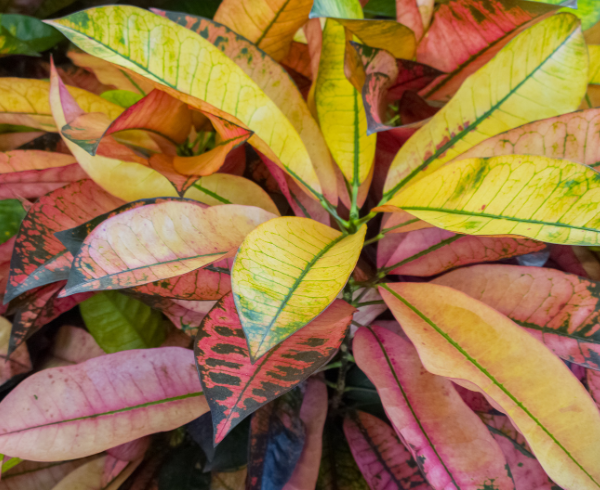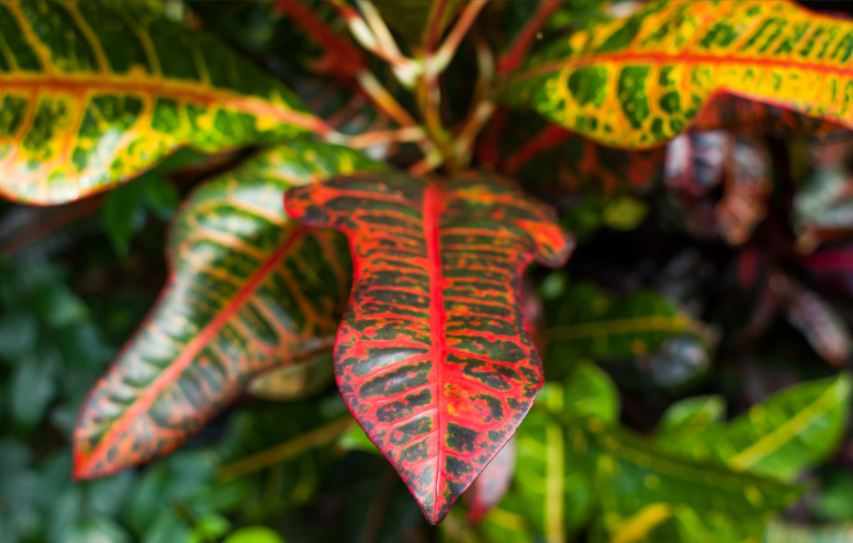
Codiaeum – Croton Plants
The Codiaeum, or croton, has leathery leaves that are variegated in a spectrum of yellows, greens, purples, bronzes, maroons, reds, and pinks—all on one plant.
And the best part is, that Codiaeum presents this spectacle throughout the year, explaining its nickname, Joseph’s Coat, after the Biblical coat of many colors. Another name is the gold dust plant.
Leaves come in a variety of shapes too, from rounded or oval to long and narrow, from straight to twisting, from smooth to notched.
A native of Malaysia, Australia, and some of the Pacific islands, Codiaeum has a tropical temperament and needs a strong dose of direct sunlight for at least two to three hours a day.
It also likes warm temperatures (at least 55 or 60 degrees), high humidity, and lots of water. The soil should be moist but not saturated. Leaves should be misted frequently and wiped with a damp cloth to prevent aphids and other pests from establishing homes.
Fertilize frequently except in winter, but be sure not to allow it to dry out completely. Generally, Codiaeum will retain a pleasant shape and do not need repotting or pruning.
But if it becomes too tall (it can grow to 3 feet), cut it back in the early spring. You can propagate fresh plants from the cuttings.
Jamaican Croton

- Scientific Name: Graptophyllum pictum
- Family: Acanthaceae
- Common Names: Jamaican Croton, Caricature plant
- Native to: Probably New Guinea
- Description: A perennial tender shrub. Leaves are variously colored green with cream, pink, or peach and shades of purple and red, dependent on the cultivar (cultivated variety), and have an elliptical shape.
The leaves are opposite on the stem, with smooth edges, glossy upper and lower surfaces, and are 4-6 inches in length.
The flowers are not the star of the show, they are 1 1/2 inches long tubular with 2 lips, and are usually red or purple, held in the terminal clusters that appear in the summer, though are rarely seen in manicured landscapes. The fruit is an inconspicuous capsule.
- Hardiness: USDA hardiness zones 9 through 11, damaged by freezing temperatures, but root hardy.
- Height/Width: Grows 6 to 9 feet tall and 4 to 6 feet wide.
- Light: Full sun to partial shade.
- Soil/Moisture: Prefers moist, but well-drained soils.
- Culture/Use: Jamaican Croton can be a large plant with attention-getting leaves. Plant it outside to draw interest in any area. Use it in the back of beds, on borders, and on large hedges; it also grows well in containers. Jamaican Croton is a good interior plant if bright light is available.
Group plants together with other moisture-loving plants such as a fern ground cover so that irrigation can be adjusted to water them specifically instead of overwatering the entire landscape.
- Misuses and Notes: Pruning can be an issue with large-leaved plants such as Jamaican Croton. Traditional powered pruning equipment will cut and tatter the leaves making an ugly plant. Jamaican Croton responds well to an occasional pruning to control the size and increase business but uses hand shears on individual branches for best results.
Some of the more popular varieties:
- Codiaeum variegatum “pictum” (Malaysia, Sunda Islands) – A beautiful shrub with highly ornamental foliage and thick and leathery ovate to linear leaves, sometimes lobed. Young leaves are green and yellow, later changing to red. There are many varieties and hybrids.
- Codiaeum “spirale” (Malaysia) – A compact plant with stiff linear leaves spirally twisted like a corkscrew. The leaves are checkered red, yellow, and green. The variegatum species alone has more than 50 cultivars besides the above.
- C. variegatum “corkscrew” – A very sturdy plant, dense with rather stiff erect, strap-shaped leaves. Deep green and metallic red and yellow, these are twisted into long spirals. In strong sunshine, the colors – golden yellow, pink, red, bluish-black – become more intense, with a conspicuously yellow midrib.
- Codiaeum variegatum “andreanum” – A plant of good compact habit with oval pointed leaves, coppery green with rich yellow veins turning to orange-red, and variegated yellow towards the leaf margin. Makes a good potted specimen.
- Codiaeum puntatum “aureum” – Dense and bushy plant with a miniaturish habit of growth. Narrow and linear, dark and glossy green leathery leaves with freely-spotted yellow in polka-dot fashion. It is a dwarfish in the early stages of growth, about 30-45cm high, and a rather slow grower.
It is ideal for planting as a low compact border or hedging. Very suitable for pot culture, there is also a version with red or orange foliage. Good for full sun areas.
How To Care For Codiaeums
Codiaeums are quite easily propagated by hard (or ripened) wood cuttings. These can be taken from mature stems. Top cuttings can also be used.
Root in the sand-peat mix or soil-peat-sand mix: in the sand-peat mix, the radio should be 2:1 and in the latter, 1:1:1.
“Crotons” require good sunshine and all plantings should be sited in an open situation. Another requirement is good, well-drained soil, which is essential for healthy plant growth.
Well-rotted organic manure is still the best for Codiaeum culture, particularly for plants in containers or pots.
Besides supplying nutrients, organics have the capacity to improve soil structure and increase moisture retention.
Codiaeums are generally free from pests apart from scale insect infestation on occasion. This is easily eradicated with white oil such as “alborol” or “albolenium”, which is effective against all sucking insects which attack ornamental plants.
Always closely follow the dosage recommendations on the label.






















